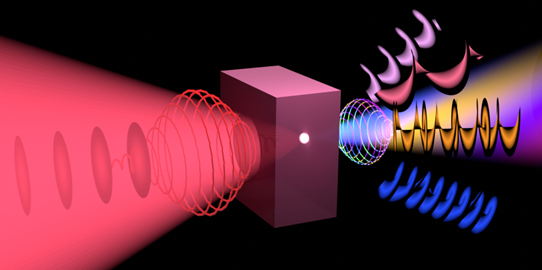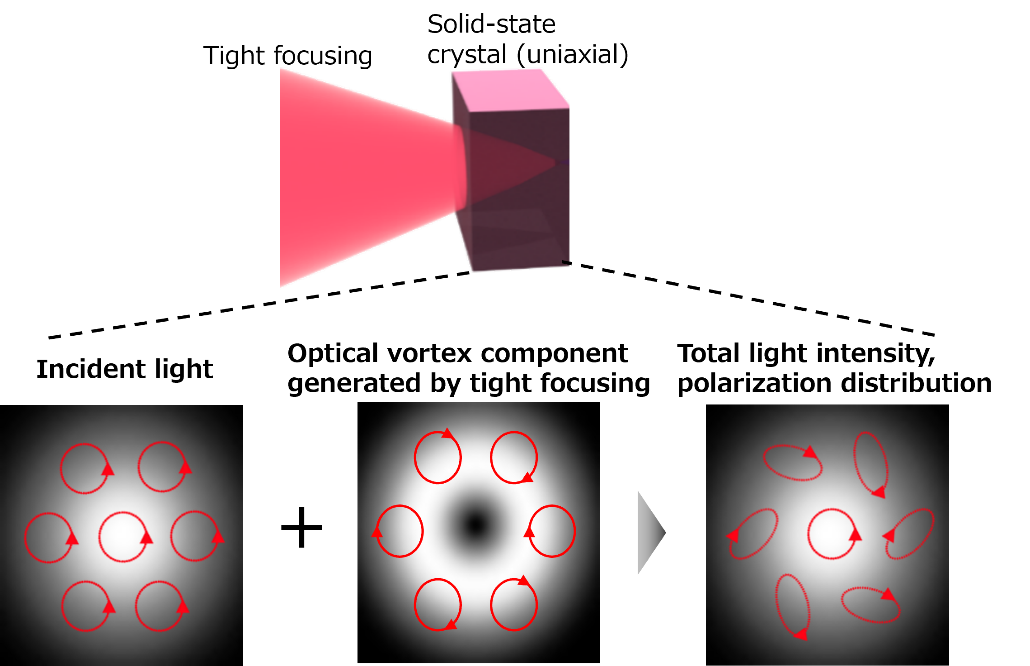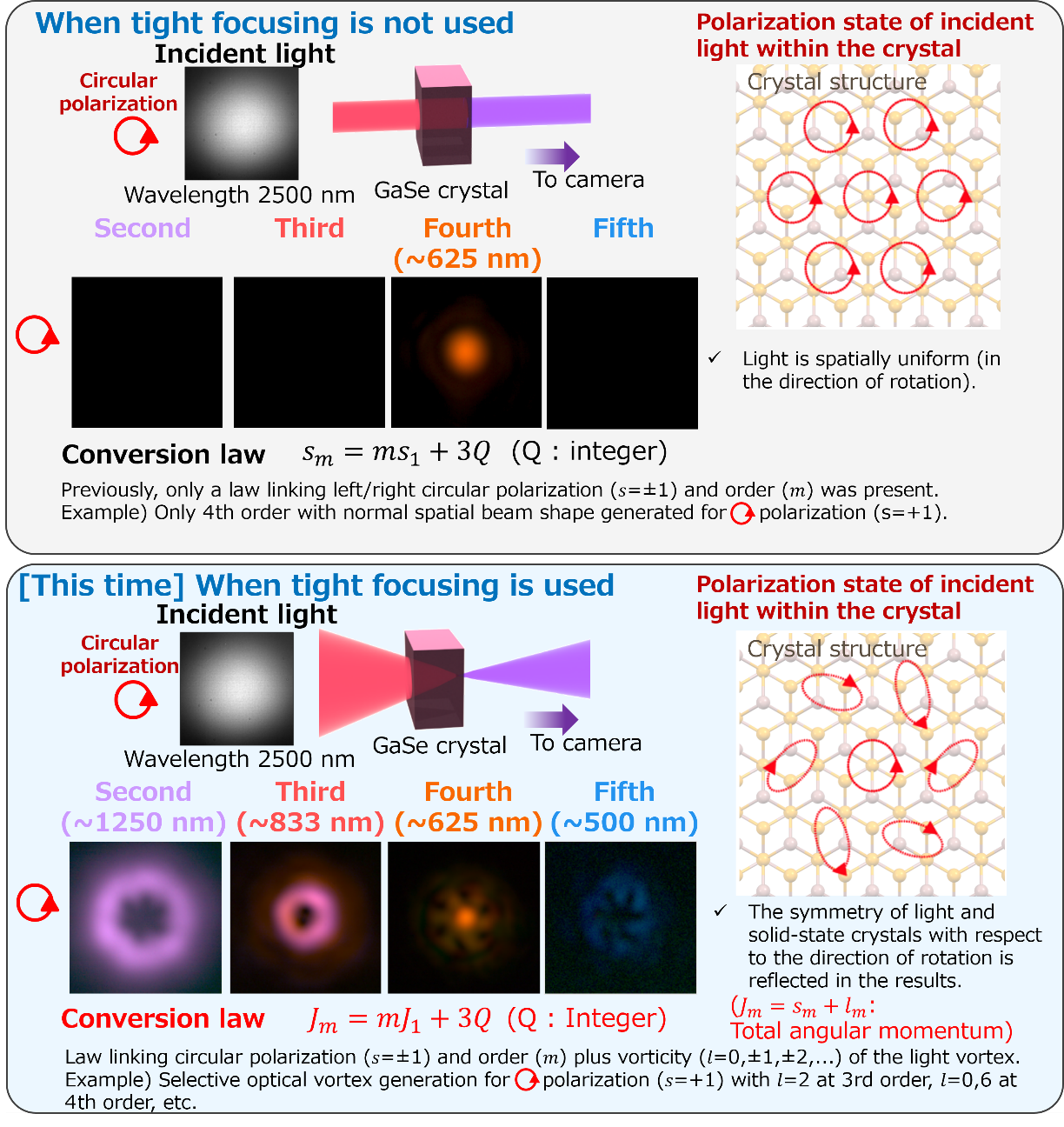Microsoft ends support for Internet Explorer on June 16, 2022.
We recommend using one of the browsers listed below.
- Microsoft Edge(Latest version)
- Mozilla Firefox(Latest version)
- Google Chrome(Latest version)
- Apple Safari(Latest version)
Please contact your browser provider for download and installation instructions.
August 21, 2024
NTT Corporation
First successful simultaneous control of optical polarization and wavefront shaping in high-harmonic generation
Clarification of the control law of light widely related to spectroscopy, laser processing, optical tweezers, information and communication, etc.
News Highlights:
- In a high harmonic generation, which is wavelength conversion using intense laser, we have succeeded in simultaneous control of polarization and wavefront shaping, which has been difficult in the past, by utilizing the characteristics of solid-state crystals
- We clarified the law that determines the types of solid-state crystals that can be used to generate light with what characteristic polarization and wavefront
- This result is a necessary guideline for the development of optical technology using harmonic generation. For example, light with controlled wavefront shaping will lead to new applications for optical tweezers, spectroscopy, laser processing, and optical communication technology
TOKYO—August 21, 2024—NTT Corporation (Headquarters: Chiyoda Ward, Tokyo; Representative Member of the Board and President: Akira Shimada; hereinafter "NTT") has succeeded for the first time in the world in simultaneously controlling the polarization and wavefront of light, which had previously been difficult to control, in high harmonic generation1, a process of wavelength conversion using intense laser (Figure 1). In this research, we took advantage of the regularity of the atomic arrangement called symmetry2 in solid-state crystals that causes wavelength conversion and discovered the light conversion law, which is a basic guideline for controlling the polarization and wavefront of generated light. These results are expected to provide new applications in various fields such as spectroscopy, laser processing, optical manipulation, and optical communications.
The results of this research were published in the online version of the American scientific journal Science Advances on August 2, 2024. This research was supported in part by a Grant-in-Aid for Scientific Research from the Japan Society for the Promotion of Science.
 Figure 1 Light with selective polarization and wavefront shaping at various wavelengths (right side) is generated from an intense infrared laser (left side) through wavelength conversion in a solid-state crystal (center)
Figure 1 Light with selective polarization and wavefront shaping at various wavelengths (right side) is generated from an intense infrared laser (left side) through wavelength conversion in a solid-state crystal (center)
1. Background
Control of important parameters3 of laser, such as color (wavelength and frequency), intensity, phase, polarization, and wavefront shaping, has led to applications in various fields, including optical communications, science, industry, and medicine. In recent years, research on the photoresponse of materials irradiated with an intense laser has advanced, leading to laser processing and wavelength conversion technologies. Wavelength conversion is an important technology to generate lasers with wavelengths to suit specific purposes. At the forefront of such research is the wavelength conversion process called high harmonic generation which is the basis of attosecond pulse generation4 that won the Nobel Prize in 2023.
At NTT Basic Research Laboratories, we have been researching high-harmonic generation for many years, and by controlling the generated harmonic light, we have been exploring new optical technologies that will lead to precise optical measurements and high-speed optical devices. Until now, we have realized the control of optical parameters such as frequency, intensity, and phase by making laser shorter pulse, shorter wavelength, and higher power. Furthermore, we aim to control all parameters of high harmonics by controlling other important optical parameters such as polarization and wavefront. However, there is no unified understanding of how the polarization and wavefront of laser are converted in high harmonic generation, and controlling them has been a challenge.
2. Key points of the technology
We focused on the state of light called circular polarization5 and optical vortex6 as methods to characterize the polarization and wavefront of the laser (Figure 2). By utilizing the symmetry2 of solid-state crystals to create optical vortices from circularly polarized light, we succeeded in simultaneously controlling the polarization converted by high harmonic generation and the wavefront shaping. We found that these transformation rules are based on universal laws that reflect the symmetry of solids.
 Figure 2 Wavefront of the optical vortex and intensity distribution of the beam cross-section when it hits the screen
Figure 2 Wavefront of the optical vortex and intensity distribution of the beam cross-section when it hits the screen
(1) High-order solid-state harmonic generation technology using symmetry
When controlling the polarization and wavefront of the light generated by wavelength conversion, it is best to pay attention to symmetry. Focusing on the dynamical symmetry2 that characterizes the temporal and spatial shape of electromagnetic waves that form laser and solid crystals, we can perform controlled polarization and wavefront conversion while maintaining the symmetry feature before and after wavelength conversion by high harmonic generation.
In this research, we used a solid-state crystal, which has attracted attention in recent years, instead of a gas-phase high harmonics generation technology using gases, which was the main medium in the past, to generate high harmonics, and controlled light using the characteristic symmetry caused by the regular atomic arrangement in the solid-state (Figure 3). The classified regularity of each solid allows the selective generation of different polarizations and wavefront shapes determined by simple laws.
 Figure 3 Differences in medium in high harmonic generation. Regularity of shape (symmetry) differs between gases and solids.
Figure 3 Differences in medium in high harmonic generation. Regularity of shape (symmetry) differs between gases and solids.
(2) An optical experimental system that mutually converts circular polarization of light and optical vortex7
We focused on the fact that focusing a circularly polarized Gaussian beam8 on a thick uniaxial crystal9 with a lens of short focal length (tight focusing) can generate the optical component of an optical vortex (Figure 4). This generates high harmonics in the same solid-state crystal while easily creating optical vortices, which conventionally require special optical elements. In addition, since the polarization and wavefront can be combined with solid-state crystals to create a state characterized by a single symmetry, it is possible to simultaneously control the polarization and wavefront of harmonic generation by symmetry.
 Figure 4 Polarization state produced by light with tight focusing (focused by a lens with a short focal length) on a solid-state crystal
Figure 4 Polarization state produced by light with tight focusing (focused by a lens with a short focal length) on a solid-state crystal
3. Outline of the experiment
Higher harmonics of various wavelengths were generated in solid crystals. Observations have revealed that control of the converted circularly polarized light and optical vortex states is achieved.
We generated a circularly polarized Gaussian beam of intense infrared femtosecond laser10 at a wavelength of 2500 nm and focused it onto a uniaxial gallium selenide (GaSe) crystal 2 mm thick using a lens with a focal length of 6 mm to generate high harmonics (Figure 5). After resolving red, orange, and blue light, which corresponds to frequencies many times higher than the frequency of the focused laser, for each polarization component, the spatial shape of the harmonic beam was confirmed by photographing the generated light with a camera. As a result, the spatial shape of the beam depending on the wavelength and polarization component was observed (Figure 6). Comparing the results with and without tight focusing, we observed doughnut-like and windmill-like beam cross-sections only when tight focusing was applied. The doughnut shape (third-order) indicates the state of a single optical vortex, and the windmill shape (fourth-order) indicates the simultaneous generation of several different optical vortices. These results reveal selective circular polarization and optical vortex states that are simultaneously controlled according to a single conversion law.
 Figure 5 Optical experimental system for high harmonic generation
Figure 5 Optical experimental system for high harmonic generation
 Figure 6 Spatial shape of the photographed harmonic beam (only the harmonic of the component of one circular polarization state is shown) and conversion law
Figure 6 Spatial shape of the photographed harmonic beam (only the harmonic of the component of one circular polarization state is shown) and conversion law
4. Outlook
The law that we discovered is a general-purpose law that determines what kind of polarization and wavefront shaping light is generated when the wavelength of the laser is converted using a solid-state crystal. This is important for the development of basic optical technology. As a specific application example, optical vortices with wavelengths in the ultraviolet region, which are difficult to obtain with conventional laser technology, are obtained by high harmonic generation. The high focusing performance on a small space due to the short wavelength is expected to be used for optical manipulation of small objects (optical tweezers), microspectroscopy, laser processing, and advanced optical communications.
Announcement magazine
Journal: Science Advances (Online publication: August 2, 2024).
Title: High harmonic spin-orbit angular momentum generation in crystalline solids preserving multiscale dynamical symmetry
Authors: Kohei Nagai*, Takuya Okamoto, Yasushi Shinohara, Haruki Sanada, and Katsuya Oguri (5 members)
[Glossary]
1.High harmonic generation
Harmonic generation is the phenomenon of generating light (harmonics) from a fundamental wave (the original laser) with a frequency that is an integer multiple of that (wavelength that is an integer fraction). The conversion process to double and triple the frequency is called second and third harmonic generation, respectively, and the conversion to higher integral multiples is generally called high harmonic generation.
2.Symmetry
Symmetry means that a physical or mathematical system can undergo certain transformations without changing its properties or shape. This is a very important concept in the laws of nature and in physical phenomena. For example, a shape is said to have rotational symmetry if it can be rotated 60°, 90°, 120°, 180 °, and so on and still appear the same. In a solid-state crystal, atoms are arranged in regular order, and the characteristic symmetry of the atomic arrangement determines the general characteristics of the response to light, unlike the case of a gas in which atoms float apart one by one. Particularly dynamical symmetry is a useful concept when matter is irradiated with very strong light. When a strong light is irradiated, the matter changes greatly from its original state, and a state in which light and matter are combined is formed. At that time, because the electromagnetic wave of light acts as a time-periodic external force on the material, the characteristics of the light response of the material can be determined by considering the dynamical symmetry, which is a symmetry that simultaneously includes both time periodicity of light and the spatial symmetry of light and material.
3.Laser beam parameters
A laser is an electromagnetic wave with parameters that characterize it, such as intensity, color (wavelength and frequency), phase, polarization, and wavefront. The color of a laser is determined by the wavelength, which is the distance between the peaks of the wave, or its frequency, which is the number of times a wave vibrates per second. The quantity that indicates where the wave peak is in time is called phase. Electric and magnetic fields vibrate in a two-dimensional plane perpendicular to a straight beam, and the direction in which they vibrate is called polarization. A wavefront is a plane that connects points of an equal phase of a light wave. The wavefront of a normal beam has the shape of a plane perpendicular to the direction of travel (Figure 2). Among these basic optical parameters, precise control of frequency, for example, is one of the important research projects being conducted at NTT Basic Research Laboratories.
Related news release URL:
https://group.ntt/en/newsrelease/2020/03/18/200318a.html
(Ultra-High Precision Optical Frequency Transfer)
https://group.ntt/en/newsrelease/2023/07/21/230721a.html
(Stabilization of an Electro-Optic Modulation-Based Optical Frequency Comb)
4.Attosecond pulse generation
Around 1990, it was found that irradiation with a strong infrared femtosecond laser10 on rare gases generated high harmonic light with a wide range of frequencies reaching the extreme ultraviolet region. In the early 2000s, it was experimentally confirmed that high harmonic light generated became pulse-like light with a duration in the order of attoseconds (10-18 seconds), and in 2023, the Nobel Prize in Physics was awarded for the technology that enabled the fastest strobe photography in human history. NTT Basic Research Laboratories has been studying the attosecond pulse generation technology for many years.
Related news release URL:
https://www.rd.ntt/brl/latesttopics/2014/12/latest_topics_201412171858.html
https://group.ntt/en/newsrelease/2016/04/11/160411b.html
https://group.ntt/en/newsrelease/2018/04/17/180417a.html
(World's fastest electronic flash using attosecond pulses)
5.Circular polarization
While linearly polarized light is a state of light in which the direction of the oscillation of the electric field is fixed in a certain direction, circularly polarized light is a state of light in which the direction of the electric field rotates with time.
6.Optical vortex
An optical vortex is a state of light in which the wavefront of light is spatially twisted. At the center of the optical vortex, there is a singularity where the phase becomes discontinuous, and the intensity distribution has a doughnut-shaped cross-section where the light intensity becomes zero at the center of the beam (Figure 2). Mathematically, it is represented by the Laguerre-Gaussian mode, which is one of the solutions of the equations describing the propagation of the laser beam. Optical vortices are currently used in various fields such as super-resolution microspectroscopy, optical tweezers for microscopic materials, and wireless optical communications.
7.Method for mutually converting circular polarization of light and optical vortex
This is one way to create optical vortices. There are many ways to create optical vortices. In most cases, the wavefront of a Gaussian beam8 is converted by a special optical element. For example, optical vortices can be converted into optical vortices by passing through a transparent plate (spiral phase plate) with a spatially spiral thickness. Among the conversion methods, there is a method in which circularly polarized light and optical vortex are converted to each other. An example is a thick uniaxial crystal9 that is focused from a direction parallel to its optical axis9 with a lens with a short focal length, which utilizes an effect called birefringence (a difference in the speed at which light travels in a material according to the polarization of light because the refractive index differs between two directions perpendicular to the direction in which light travels) of light. In physics, the rotational direction of circularly polarized light corresponds to the spin angular momentum (a quantity representing the rotational motion of a particle), and the number of turns of the wavefront of an optical vortex corresponds to the orbital angular momentum (a quantity representing the orbital motion of a particle). Therefore, the effect called "spin-orbit coupling" is drawing attention as an analogy to light.
8.Gaussian beam
A beam with a planar wavefront shape (not an optical vortex) and a cross-sectional structure that gradually decreases in intensity (according to a Gaussian function) from the center of the beam outward is a conventional laser beam and is called a Gaussian beam (Figure 2).
9.Uniaxial crystal
A crystal with a refractive index of light that differs only along one axis. The direction of one axis is called the optical axis.
10.Femtosecond laser
A laser beam that emits a temporal pulse rather than a steady state and duration is in the order of femtoseconds (10-15 seconds).
About NTT
NTT contributes to a sustainable society through the power of innovation. We are a leading global technology company providing services to consumers and businesses as a mobile operator, infrastructure, networks, applications, and consulting provider. Our offerings include digital business consulting, managed application services, workplace and cloud solutions, data center and edge computing, all supported by our deep global industry expertise. We are over $97B in revenue and 330,000 employees, with $3.6B in annual R&D investments. Our operations span across 80+ countries and regions, allowing us to serve clients in over 190 of them. We serve over 75% of Fortune Global 100 companies, thousands of other enterprise and government clients and millions of consumers.
Media contact
NTT Science and Core Technology Laboratory Group
Public Relations
nttrd-pr@ml.ntt.com
Information is current as of the date of issue of the individual press release.
Please be advised that information may be outdated after that point.
NTT STORY
WEB media that thinks about the future with NTT










